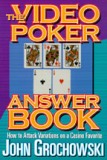
The Video Poker Answer Book
Jacks or Better Q & A
Recognizing a strong game and pay table is half the battle in video poker --- you will do better in the long run on a 9-6 Jacks or better game, paying 9-for-1 on full houses and
6-for-1 on flushes, John Grochowski is the author of six gaming books including the "Answer Book" series -- The Casino Answer Book, The Video Poker Answer Book, The Craps Answer Book and a revised edition of The Slot Machine Answer Book. His articles cover blackjack, slots and video poker strategy as well as casino etiquette and getting the most bang for your buck in Vegas. John's website is www.casinoanswerman.com than you will on an 8-5 game, with reduced full house and flush payoffs. But once you’ve chosen your game, whether online or in a brick and mortar casino, you still have to know when to hold ‘em and know when to fold ‘em.The place to start for any video poker player is Jacks or better. You can always move to flashier games, more volatile games and adjust to their quirkier strategies later.
John Grochowski is the author of six gaming books including the "Answer Book" series -- The Casino Answer Book, The Video Poker Answer Book, The Craps Answer Book and a revised edition of The Slot Machine Answer Book. His articles cover blackjack, slots and video poker strategy as well as casino etiquette and getting the most bang for your buck in Vegas. John's website is www.casinoanswerman.com than you will on an 8-5 game, with reduced full house and flush payoffs. But once you’ve chosen your game, whether online or in a brick and mortar casino, you still have to know when to hold ‘em and know when to fold ‘em.The place to start for any video poker player is Jacks or better. You can always move to flashier games, more volatile games and adjust to their quirkier strategies later.
Let’s try five sample hands for this 9-6 Jacks or better Q&A.
For each hand below, choose the best play in 9-6 Jacks or Better:
Question 1) You're dealt Queen of spades, 8 of hearts, 6 of diamonds, 3 of spades and 3 of clubs:
A. Hold the pair of 3s.
B. Hold the Queen.
Answer 1) A. Most inexperienced video poker players undervalue low pairs. Match one card on the draw, and you have three of a kind. A low pair is a good start toward two pair, even full houses and four of a kind. The expected value, or EV, of the low pair here is 4.1, meaning that in the long run; making this play will bring us an average of 4.1 coins in return for every five coins we wager. That's far better than the 2.4 EV on holding the Queen. Holding the Queen by itself gives you four shots at a high pair for a 1-for-1 payback, but most of your winners will be those single pairs. You'll get more multiple-coin winners by holding the low pair instead.
Question 2) You're dealt Queen of spades, 6 of hearts, 5 of clubs, 4 of diamonds and 3 of spades:
A. Hold the four-card straight.
B. Hold the King.
Answer 2) A. The EV on a four-card straight is 3.4, not quite as good as a low pair, but still better than the 2.4 on a Queen.
Question 3) You're dealt Queen of diamonds, Jack of spades, 9 of hearts, 6 of clubs and 2 of diamonds:
A. Hold the Jack.
B. Hold the Queen
C. Hold Queen and Jack.
Answer 3) C. With two high cards at the start, you have a better chance of pairing one of them for paying hand, and there still are possibilities for two pair, three of a kind, full houses, four of a kind, even straights. Two high cards aren't a great start, but with an EV of a little less than 2.6, they're better than those of between 2.3 and 2.4 for single high cards.
Question 4) You're dealt Ace of diamonds, Queen of spades, Jack of hearts, 5 of hearts and 2 of clubs:
A. Hold Ace-Queen-Jack.
B. Hold Queen-Jack.
C. Hold the Ace.
D. Hold the Queen.
E. Hold the Jack.
Answer 4) B. Aces get in the way of straights. When you hold an Ace with other high cards, the only possible straights are Ace high. We hold an Ace with one other high card, but discard it with two other high cards of mixed suits. Here, the EV of Queen-Jack is 2.5, while all the other options are 2.3 or lower.
Question 5) You're dealt King-Queen-Jack-10 of clubs and Ace of hearts:
A. Hold the straight.
B. Hold the four diamonds.
Answer 5) B. We have to take our 1-in-47 shot at the big royal flush jackpot, usually 4,000 coins for five played. We break up the straight, giving away a sure 20-coin winner, for the possibility of much more. The EV is 98.0 for the four-card royal, much better than the 20-coin win we'd claim by keeping the straight.

